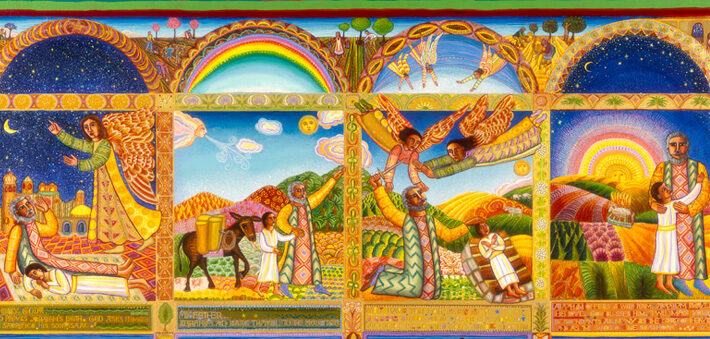Commentary on Genesis 21:1-3; 22:1-14
Part of the enduring intrigue of the story of Abraham’s near-sacrifice of Isaac likely grows out of its pregnant minimalism.1 The narrative details are sparse but layered with substance. The conversations are terse but, as Erich Auerbach observed, designed not to externalize inner dialogue but to “indicate thoughts which remain unexpressed.”2
It is no wonder that for several millennia Jewish and Christian interpreters alike have attempted to fill in the gaps that litter this evidently meaningful and disconcertingly ambiguous story. One early strategy for finding answers, which we see beginning in pre-Christian Second Temple era literature, is the insertion of extra characters into the action—many of them nonhuman. Though they are never mentioned in Genesis 22, in early Jewish interpretation we find angels, demons, and other hard-to-categorize figures playing central roles.
The reasons behind these insertions are varied, but one important factor was that early interpreters employed these figures to examine the theological problem posed by this story’s gut-wrenching violence. Demons and devils were introduced into the tradition not to villainize enemies or stereotype the nature of evil, but to deal with fundamental questions regarding the relationship between God and God’s people.
The Aqedah, as it is commonly called in Jewish tradition (from the Hebrew word for “bind” in Genesis 22:9), is framed in Genesis as a “test”:
After these things God tested Abraham. He said to him, “Abraham!” And he said, “Here I am.” (Genesis 22:1 NRSV)
The Hebrew word translated as “test”, nisah, does not appear in the narrative again and this has led many interpreters to wonder what exactly is being tested and why. When the second century BCE book of Jubilees retold the Aqedah, it included a creative explanation of just this point:
Then Prince Mastema came and said before God: “Abraham does indeed love his son Isaac and finds him more pleasing than anyone else. Tell him to offer him as a sacrifice on an altar. Then you will see whether he performs this order and will know whether he is faithful in everything through which you test him.” (Jubilees 17:16)3
Here, the author of Jubilees has inserted a satan-type figure, Prince “Mastema” (from the Hebrew word for “hatred”), who instigates this test of Abraham. The scene is intentionally evocative of the prologue of Job where Job’s misfortunes in the book are introduced as the result of a wager between God and the satan (Job 1:9-12).
Other ancient Jewish versions of the story envision the Aqedah as the result of conflicts in heaven. Pseudo-Philo, a text dating to the first or second century CE, explains that the events are caused by jealous angels.
And [God] gave [Abraham] a son at the end of his old age and took him out of a sterile womb. And all the angels were jealous of him, and the worshiping hosts envied him. And since they were jealous of him, God said to him, “Kill the fruit of your body for me, and offer for me as a sacrifice what has been given to you by me.” And Abraham did not argue, but set out immediately. (L.A.B. 32:1–2)4
These same angels are then put to shame at the end of the story when Pseudo-Philo envisions a speech from Isaac in which he goes to the sacrifice willingly as a martyr.
[Isaac said], “yet have I not been born into the world to be offered as a sacrifice to him who made me? Now my blessedness will be above that of all men, because there will be nothing like this; and about me future generations will be instructed and through me the peoples will understand that the Lord has made the soul of a man worthy to be a sacrifice.” (L.A.B. 32:3)
The story is thus reframed, not as a test of Abraham (or Isaac, as in other sources), but as a display of their faithfulness for the benefit of all of heaven and, indeed, all of humanity.
In later traditions, these extra characters attempt to interfere directly with the Aqedah. The collection of midrashim from the fourth to fifth centuries CE called Genesis Rabbah, for example, adds a differ satan-type figure (this one called Samael) to antagonize Abraham and Isaac as they travel along the road to Moriah.
Samael came close to our father Abraham and said to him, “Old Man, Old Man, have you lost your mind? A son was given to you at the age of one hundred and you go to slay him? [Abraham] said, “Even this.” [Samael] said to him, “And if [God] tests you more than this, are you able to stand it? ‘If one tries a word with you, will you be wearied?’ (Job 4:2).” [Abraham] said, “Even more than this.” [Samael] said to him, “Tomorrow [God] will say to you, ‘Murderer, you are guilty, for you have spilled the blood of your son.’” [Abraham] said, “Even this.” (Gen. Rab. 56:4, author’s translation)
Here again is another allusion to the book of Job. The interlocutor quotes Job 4:2 (the only place in the book where the word nisah, “test” appears) and attempts to deter Abraham from obeying God’s command (see also a longer version in b. Sanhedrin 89b). The conversation is reminiscent of Jesus’ encounter with the devil in the wilderness (Matt 4:1–11 // Mark 1:12–13 // Luke 4:1–13). In both sets of stories, an oppositional figure quotes scripture and tries to dissuade someone from carrying out a difficult but necessary “test” from God (peirazō, Matt 4:1 // Mark 1:13 // Luke 4:2).
What does inserting these characters into the Aqedah accomplish theologically? One purpose may have been to give voice to doubts and concerns held by the community, but which may have been perceived as irreverent or contrarian. More broadly, however, these figures flesh out the ethical and theological cruxes of the story:
Was the command to sacrifice Isaac an evil act, triggered by the devil?
Did God really not know what would happen?
Are Abraham and Isaac exceptionally faithful figures or are they models for who we all are meant to be?
Many of these questions are the same ones that provoke interpreters of this story today. These retellings are thus helpful reminders that we are not the first readers of the Bible to be troubled by the Aqedah. Nor will we be the last.
Notes
- This post is adapted from my essay, “Provocateurs, Examiners, and Fools: Divine Opponents to the Aqedah in Early Judaism,” Catholic Biblical Quarterly 83 (2021): 373–89.
- Erich Auerbach, “Odysseus’ Scar,” in Mimesis: The Representation of Reality in Western Literature, trans. W. R. Trask (Princeton: Princeton University, 1953), 3–23.
- Translation from James C. Vanderkam, The Book of Jubilees: Translated (Corpus Scriptorum Christianorum Oreintalium 511; Louwain: Peeters, 1989).
- Translations from Daniel J. Harrington, “Pseudo-Philo” in The Old Testament Pseudepigrapha, vol. 2 (ed. James Charlesworth; New Haven: Yale University Press, 1983) 304–77, 345.
PRAYER OF THE DAY
God of promise,
You stayed the hand of Abraham and fulfilled the promise you made to him, that he would father a great nation. Keep your promises to us, that we become inheritors of eternal life. Amen.
HYMNS
The God of Abraham praise ELW 831
A lamb goes uncomplaining forth ELW 340
CHORAL
Listen to the lambs, William Dawson


September 19, 2021